A few photos have now (finally) been added to my previous article, The Loss and Recovery of the Anchors from Matthew Flinders’ Ship HMS Investigator. Doug Seton has since provided me with many more photos to add to the story. In order to ensure that everyone has a chance to see these photos, they are all provided below.
The large anchor inside the South Australian Maritime Museum is from Matthew Flinders’ ship HMS Investigator. It is a 4m-long, 1 tonne stocked anchor and it is possibly the oldest known anchor in South Australia. It has a (replica) large wooden stock.
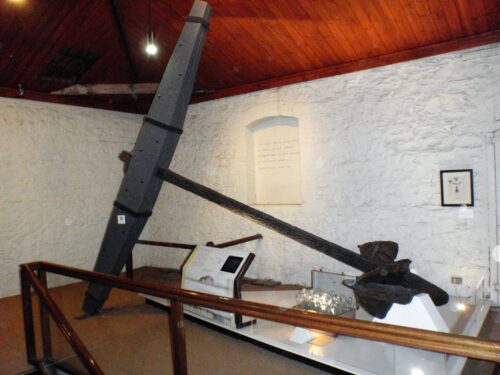
(Photo taken by Steve Reynolds)
It was the ‘best bower’ anchor from HMS Investigator, the largest of two (possibly 3) anchors that were cut loose by Matthew Flinders during rising winds in 1803. It was located in Goose Island Bay at Middle Island, Western Australia on 14th January 1973 by members of the Underwater Explorers Club of South Australia.
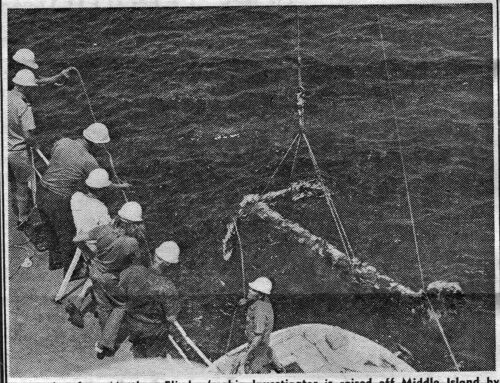
Two anchors were both raised up by the lighthouse ship Cape Don on 19th January 1973
(Photo from The West Australian newspaper on 2nd February 1973)
According to “Ill-Starred Captains – Flinders and Baudin” by Anthony J. Brown, the loss of the anchor occurred during Matthew Flinders’ circumnavigation of Australia in HMS Investigator. The ship was returning to Port Jackson (Sydney Cove) from Timor in 1803. Having reached the southern coast of Australia, and sailing east of Esperance, she headed for the Recherche Archipelago.
Some of her crew were sick and dying at this point. Several of them had gone from good to bad health quickly. This led to barely having enough crew to sail the ship. On 17th May 1803, the Investigator anchored in Middle Island’s Goose Island Bay. The bay is named after an island in the bay.
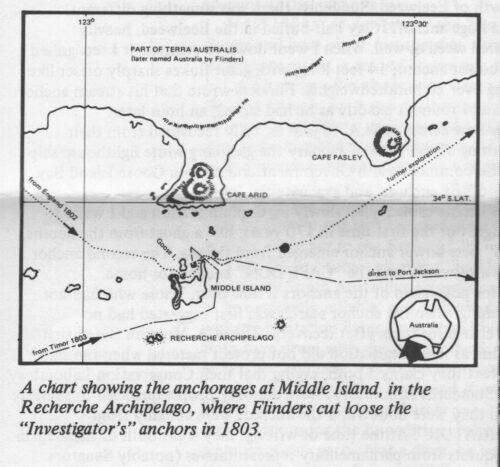
(Photo taken by Doug Seton, taken from “The Expedition to Recover Matthew Flinders’ Anchors”, SASTA July 1973)
Middle Island is the largest island in the Recherche Archipelago. It is located mid-way in the archipelago. It seems that it may have formerly been known as Manduran Island. The archipelago and many of its islands were named by Rear-Admiral Bruni d’Entrecasteaux when he was searching for missing explorer Jean-Francois de La Perouse in 1792. D’Entrecasteaux’s vessels were the Recherche and the Esperance. Esperance and the Recherche Archipelago were named after these two ships.There are said to be some 105 islands, 1500 islets and many barely submerged rocks that make up the complete archipelago.
To cut a long story short, Doug Seton headed an expedition in January 1973. The group made good use of an iron shack that they found on Middle Island that had been built by a fishing group in 1952.
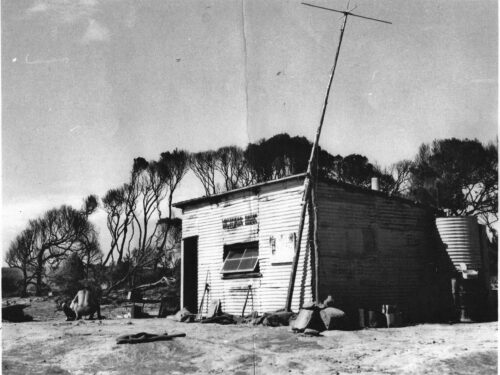
The iron shack on Middle Island
(Photo courtesy of Doug Seton)
The 4m best bower anchor was found on 14th January 1973.
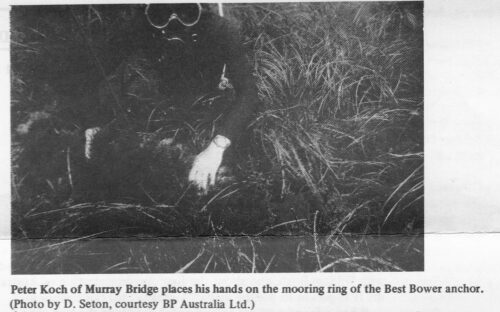
(Photo taken by Doug Seton, taken from “The Expedition to Recover Matthew Flinders’ Anchors”, SASTA July 1973)
A further search nearby located the 3m-long stream anchor. A lighthouse tender vessel called the CLS Cape Don was soon on hand to assist in recovering the two anchors. They were both hoisted aboard the Cape Don on 19th January, almost 170 years after being cut loose by Flinders.
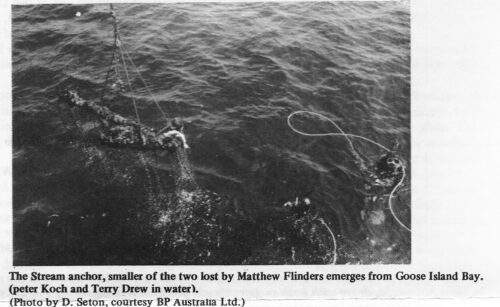
(Photo taken by Doug Seton, taken from “The Expedition to Recover Matthew Flinders’ Anchors”, SASTA July 1973)
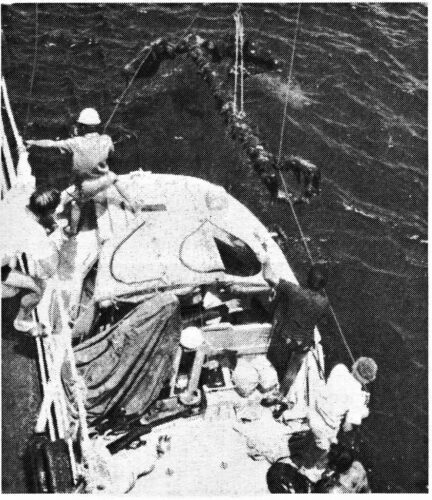
(Photo from “The Skindiver’s Underwater World” by Graeme R Dodd”)
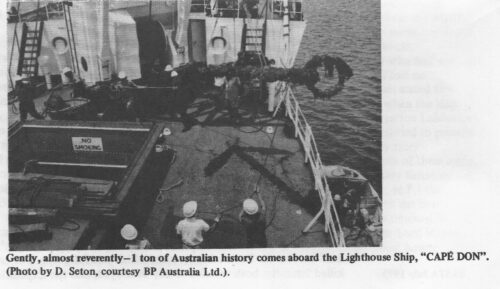
(Photo taken by Doug Seton, taken from “The Expedition to Recover Matthew Flinders’ Anchors”, SASTA July 1973)
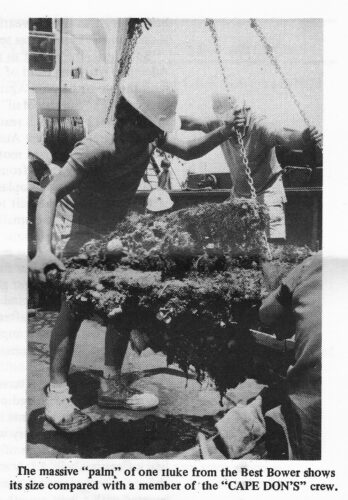
(Photo taken by Doug Seton, taken from “The Expedition to Recover Matthew Flinders’ Anchors”, SASTA July 1973)
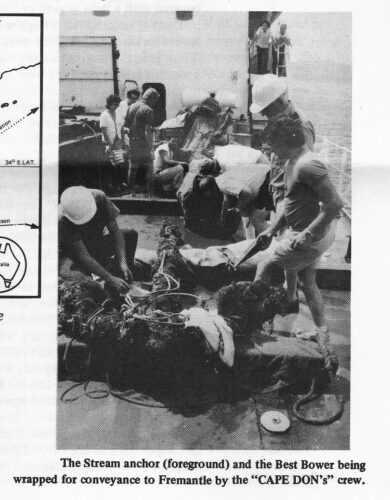
(Photo taken by Doug Seton, taken from “The Expedition to Recover Matthew Flinders’ Anchors”, SASTA July 1973)
The Cape Don took the two anchors to Fremantle, WA where they were to be preserved for display.
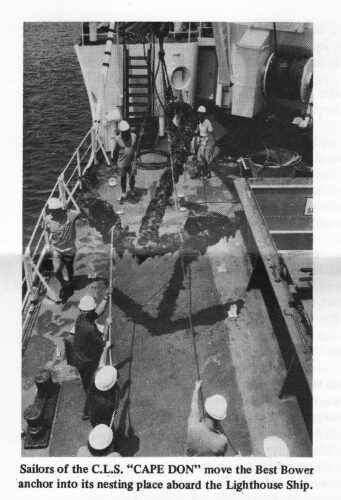
The best bower anchor being stored on Cape Don
(Photo courtesy of Doug Seton)
My thanks go to Doug Seton for providing me with much of the detail reported above.


[…] that raised the two anchors from Matthew Flinders’ ship Investigator in 1973, as reported in Photos of the Recovery of the Lost Anchors from Matthew Flinders’ Ship HMS Investigator […]